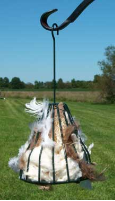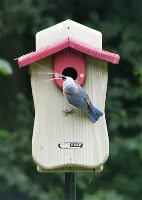-
Bird Nesting Materials Will Attract More Species
Attract more feathered friends to your yard with nesting materials.
You can encourage nest building in your yard and attract more wild birds by offering bird nesting materials such as; feathers, cotton yarns and strings, hemp and aspen fiber. Several holders and kits with refills make it an easy task that yields favorable results – for you and the birds!
The Birdie Bell shown at left is a versatile nest material vessel that can be used year round. Shaped to hold the common birdseed bells for winter feeding, they also hold orange halves and other fruits for summer time feeding for orioles, woodpeckers and others.
Nesting wreaths contain some of the favorite bird nesting materials mentioned above, and also have refills available. North American non-cavity dwellers will seek these materials to build suitable nests. Add a fresh water source such as a bird bath, and if there are trees and shrubs in your yard to offer cover, and not too many predators…you’ll see birds who never even visit your feeders.
With spring upon us, it’s quite favorable that feathered friends will take up residence soon!
-
No Need to Clean Out a Wood Birdhouse Right Now!
Wish I’d seen this info a bit earlier….
like before removing the nest from my Bluebird house a few weeks ago! They say it’s called “Spring Cleaning” for a reason, and not wise to clean houses in fall. By leaving nesting materials in a wood birdhouse over cold winter months, it helps to reduce bird parasites by allowing the birds’ own natural defenses against them to develop.
Woodpeckers and others who do not gather their own nesting materials may be enticed to these nesting sites as well. So, next time you’re ready for spring cleaning…wait until spring!
-
Attract More Birds with Nesting Material
Hanging birdhouses is wonderful, and it really does help may species to flourish and thrive. However, not all birds use them. Some are cavity dwellers (who use birdhouses and holes in tree trunks) and non cavity dwelling birds. These birds tend to nest in tree canopy, thickets, and shrubs. Some are more creative, and may use man-made elements, such as your chimney, or the Boston Fern on your porch! The key is to offer the nesting material before the season begins. Late winter is best, and in the vicinity of bird feeders where it will be seen by feathered friends.
You can attract more birds by offering nesting material. Usually a combination of feathers, string, cotton, hemp, and aspen fibers, these are some favorites among the nest builders.
The versatile Birdie Bell shown above, comes filled with this 5-blend nest material, and may be also be used to offer fruit, seed bells or suet, depending on the season.




